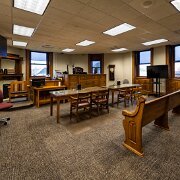
1 The Clinton County Courthouse in Clinton, Iowa, completed in 1897, is an imposing example of Richardsonian Romanesque architecture, designed by architect G.S. Mansfield. Constructed of red sandstone with granite trim, the courthouse is characterized by its massive stone walls, rounded arches, and a commanding central clock tower that rises more than 200 feet, making it a dominant feature of the city’s skyline. The richly detailed exterior includes turrets and intricate stonework, while the interior showcases grand staircases, decorative woodwork, and stained-glass windows that reflect the craftsmanship of the era. Built during a time of economic prosperity, the courthouse was intended to symbolize the strength, stability, and permanence of county government, and it continues to serve as both the judicial and administrative heart of Clinton County while standing as a proud architectural landmark.

2 The Clinton County Courthouse in Clinton, Iowa, completed in 1897, is an imposing example of Richardsonian Romanesque architecture, designed by architect G.S. Mansfield. Constructed of red sandstone with granite trim, the courthouse is characterized by its massive stone walls, rounded arches, and a commanding central clock tower that rises more than 200 feet, making it a dominant feature of the city’s skyline. The richly detailed exterior includes turrets and intricate stonework, while the interior showcases grand staircases, decorative woodwork, and stained-glass windows that reflect the craftsmanship of the era. Built during a time of economic prosperity, the courthouse was intended to symbolize the strength, stability, and permanence of county government, and it continues to serve as both the judicial and administrative heart of Clinton County while standing as a proud architectural landmark.

3 The Clinton County Courthouse in Clinton, Iowa, completed in 1897, is an imposing example of Richardsonian Romanesque architecture, designed by architect G.S. Mansfield. Constructed of red sandstone with granite trim, the courthouse is characterized by its massive stone walls, rounded arches, and a commanding central clock tower that rises more than 200 feet, making it a dominant feature of the city’s skyline. The richly detailed exterior includes turrets and intricate stonework, while the interior showcases grand staircases, decorative woodwork, and stained-glass windows that reflect the craftsmanship of the era. Built during a time of economic prosperity, the courthouse was intended to symbolize the strength, stability, and permanence of county government, and it continues to serve as both the judicial and administrative heart of Clinton County while standing as a proud architectural landmark.
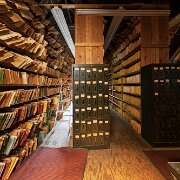
4 The Clinton County Courthouse in Clinton, Iowa, completed in 1897, is an imposing example of Richardsonian Romanesque architecture, designed by architect G.S. Mansfield. Constructed of red sandstone with granite trim, the courthouse is characterized by its massive stone walls, rounded arches, and a commanding central clock tower that rises more than 200 feet, making it a dominant feature of the city’s skyline. The richly detailed exterior includes turrets and intricate stonework, while the interior showcases grand staircases, decorative woodwork, and stained-glass windows that reflect the craftsmanship of the era. Built during a time of economic prosperity, the courthouse was intended to symbolize the strength, stability, and permanence of county government, and it continues to serve as both the judicial and administrative heart of Clinton County while standing as a proud architectural landmark.

5 The Clinton County Courthouse in Clinton, Iowa, completed in 1897, is an imposing example of Richardsonian Romanesque architecture, designed by architect G.S. Mansfield. Constructed of red sandstone with granite trim, the courthouse is characterized by its massive stone walls, rounded arches, and a commanding central clock tower that rises more than 200 feet, making it a dominant feature of the city’s skyline. The richly detailed exterior includes turrets and intricate stonework, while the interior showcases grand staircases, decorative woodwork, and stained-glass windows that reflect the craftsmanship of the era. Built during a time of economic prosperity, the courthouse was intended to symbolize the strength, stability, and permanence of county government, and it continues to serve as both the judicial and administrative heart of Clinton County while standing as a proud architectural landmark.

6 The Clinton County Courthouse in Clinton, Iowa, completed in 1897, is an imposing example of Richardsonian Romanesque architecture, designed by architect G.S. Mansfield. Constructed of red sandstone with granite trim, the courthouse is characterized by its massive stone walls, rounded arches, and a commanding central clock tower that rises more than 200 feet, making it a dominant feature of the city’s skyline. The richly detailed exterior includes turrets and intricate stonework, while the interior showcases grand staircases, decorative woodwork, and stained-glass windows that reflect the craftsmanship of the era. Built during a time of economic prosperity, the courthouse was intended to symbolize the strength, stability, and permanence of county government, and it continues to serve as both the judicial and administrative heart of Clinton County while standing as a proud architectural landmark.
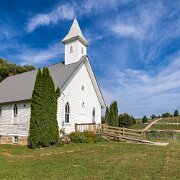
7 The Buckhorn Church, located near Maquoketa in Jackson County, Iowa, is one of the few remaining landmarks of the once-bustling rural community of Buckhorn. Established in the late 19th or early 20th century, the church served as a spiritual and social center for the area’s farming families, who also supported a thriving creamery and small businesses. The simple white wooden structure, complete with a modest steeple and traditional clapboard siding, reflects the unadorned yet enduring character of Midwestern rural church architecture.
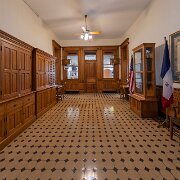
8 The Iowa County Courthouse in Marengo was completed in 1893 as the fourth courthouse for the county; its predecessors—a log structure, a stone building, and a brick courthouse—proved inadequate as the population grew. It cost about $57,600 to build, much of that raised by auctioning off swamp lands the county owned. The courthouse is a Romanesque Revival building designed by the Des Moines firm Foster & Liebbe, built of Berea sandstone, and is distinguished by a commanding 137-foot entrance tower capped with an octagonal lantern and steep spire. Inside it features two stories with antique oak finishes, fire-proof vaults for official records, steam heating, and early electric lighting, reflecting late 19th-century civic ambitions.
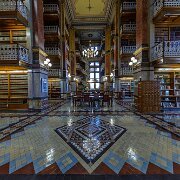
9 The State Law Library inside the Iowa State Capitol is one of the building’s most celebrated interior spaces, renowned for both its history and architectural beauty. Established alongside the Capitol’s completion in the 1880s, the library reflects the grandeur of the era with its Victorian design, featuring four tiers of cast-iron spiral staircases, ornamental railings, and balconies that rise dramatically around the reading room. Its tall arched windows flood the space with natural light, highlighting the marble floors, richly carved woodwork, and decorative details that emphasize elegance and craftsmanship.
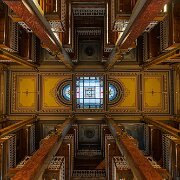
10 The State Law Library inside the Iowa State Capitol is one of the building’s most celebrated interior spaces, renowned for both its history and architectural beauty. Established alongside the Capitol’s completion in the 1880s, the library reflects the grandeur of the era with its Victorian design, featuring four tiers of cast-iron spiral staircases, ornamental railings, and balconies that rise dramatically around the reading room. Its tall arched windows flood the space with natural light, highlighting the marble floors, richly carved woodwork, and decorative details that emphasize elegance and craftsmanship.

11 The State Law Library inside the Iowa State Capitol is one of the building’s most celebrated interior spaces, renowned for both its history and architectural beauty. Established alongside the Capitol’s completion in the 1880s, the library reflects the grandeur of the era with its Victorian design, featuring four tiers of cast-iron spiral staircases, ornamental railings, and balconies that rise dramatically around the reading room. Its tall arched windows flood the space with natural light, highlighting the marble floors, richly carved woodwork, and decorative details that emphasize elegance and craftsmanship.

12 The State Law Library inside the Iowa State Capitol is one of the building’s most celebrated interior spaces, renowned for both its history and architectural beauty. Established alongside the Capitol’s completion in the 1880s, the library reflects the grandeur of the era with its Victorian design, featuring four tiers of cast-iron spiral staircases, ornamental railings, and balconies that rise dramatically around the reading room. Its tall arched windows flood the space with natural light, highlighting the marble floors, richly carved woodwork, and decorative details that emphasize elegance and craftsmanship.
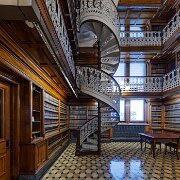
13 The State Law Library inside the Iowa State Capitol is one of the building’s most celebrated interior spaces, renowned for both its history and architectural beauty. Established alongside the Capitol’s completion in the 1880s, the library reflects the grandeur of the era with its Victorian design, featuring four tiers of cast-iron spiral staircases, ornamental railings, and balconies that rise dramatically around the reading room. Its tall arched windows flood the space with natural light, highlighting the marble floors, richly carved woodwork, and decorative details that emphasize elegance and craftsmanship.
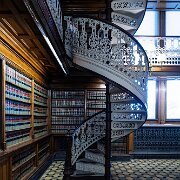
14 The State Law Library inside the Iowa State Capitol is one of the building’s most celebrated interior spaces, renowned for both its history and architectural beauty. Established alongside the Capitol’s completion in the 1880s, the library reflects the grandeur of the era with its Victorian design, featuring four tiers of cast-iron spiral staircases, ornamental railings, and balconies that rise dramatically around the reading room. Its tall arched windows flood the space with natural light, highlighting the marble floors, richly carved woodwork, and decorative details that emphasize elegance and craftsmanship.

15 The State Law Library inside the Iowa State Capitol is one of the building’s most celebrated interior spaces, renowned for both its history and architectural beauty. Established alongside the Capitol’s completion in the 1880s, the library reflects the grandeur of the era with its Victorian design, featuring four tiers of cast-iron spiral staircases, ornamental railings, and balconies that rise dramatically around the reading room. Its tall arched windows flood the space with natural light, highlighting the marble floors, richly carved woodwork, and decorative details that emphasize elegance and craftsmanship.

16 The State Law Library inside the Iowa State Capitol is one of the building’s most celebrated interior spaces, renowned for both its history and architectural beauty. Established alongside the Capitol’s completion in the 1880s, the library reflects the grandeur of the era with its Victorian design, featuring four tiers of cast-iron spiral staircases, ornamental railings, and balconies that rise dramatically around the reading room. Its tall arched windows flood the space with natural light, highlighting the marble floors, richly carved woodwork, and decorative details that emphasize elegance and craftsmanship.
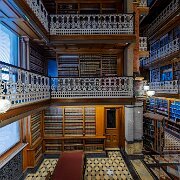
17 The State Law Library inside the Iowa State Capitol is one of the building’s most celebrated interior spaces, renowned for both its history and architectural beauty. Established alongside the Capitol’s completion in the 1880s, the library reflects the grandeur of the era with its Victorian design, featuring four tiers of cast-iron spiral staircases, ornamental railings, and balconies that rise dramatically around the reading room. Its tall arched windows flood the space with natural light, highlighting the marble floors, richly carved woodwork, and decorative details that emphasize elegance and craftsmanship.
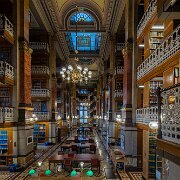
18 The State Law Library inside the Iowa State Capitol is one of the building’s most celebrated interior spaces, renowned for both its history and architectural beauty. Established alongside the Capitol’s completion in the 1880s, the library reflects the grandeur of the era with its Victorian design, featuring four tiers of cast-iron spiral staircases, ornamental railings, and balconies that rise dramatically around the reading room. Its tall arched windows flood the space with natural light, highlighting the marble floors, richly carved woodwork, and decorative details that emphasize elegance and craftsmanship.
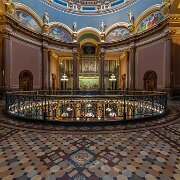
19 The Iowa State Capitol in Des Moines, built between 1871 and 1886, is the only five-domed state capitol in the United States and represents the Renaissance Revival style popular in the late 19th century. Designed by architects John C. Cochrane and Alfred H. Piquenard, its most striking feature is the central dome covered in 23-karat gold leaf, flanked by four smaller copper domes. Constructed of brick, steel, and Iowa limestone, the building combines strength with elegance, while its decorative details reflect the craftsmanship of the era. Extensive restorations, including multiple regildings of the dome, have preserved its architectural splendor, making the Capitol both a working seat of government and a lasting symbol of Iowa’s history and civic pride.

20 The Iowa State Capitol in Des Moines, built between 1871 and 1886, is the only five-domed state capitol in the United States and represents the Renaissance Revival style popular in the late 19th century. Designed by architects John C. Cochrane and Alfred H. Piquenard, its most striking feature is the central dome covered in 23-karat gold leaf, flanked by four smaller copper domes. Constructed of brick, steel, and Iowa limestone, the building combines strength with elegance, while its decorative details reflect the craftsmanship of the era. Extensive restorations, including multiple regildings of the dome, have preserved its architectural splendor, making the Capitol both a working seat of government and a lasting symbol of Iowa’s history and civic pride.
Iowa